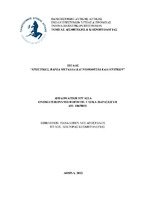| dc.contributor.advisor | Παπαδόπουλος, Απόστολος | |
| dc.contributor.author | Γλύκα, Παρασκευή | |
| dc.date.accessioned | 2022-07-18T06:49:21Z | |
| dc.date.available | 2022-07-18T06:49:21Z | |
| dc.date.issued | 2022-07-11 | |
| dc.identifier.uri | https://polynoe.lib.uniwa.gr/xmlui/handle/11400/2521 | |
| dc.identifier.uri | http://dx.doi.org/10.26265/polynoe-2361 | |
| dc.description.abstract | Η συνεχώς αυξανόμενη ζήτηση για τα καλλυντικά προϊόντα έχει δημιουργήσει την ανάγκη για αυστηρότερο έλεγχο της σύστασης τους. Οι χρωστικές ύλες που προστίθενται σε αυτά αποσκοπούν στο χρωματισμό του δέρματος ή του ίδιου του προϊόντος ώστε να το καταστήσουν πιο ελκυστικό στα μάτια του καταναλωτή. Παλαιότερα ο χρωματισμός προέκυπτε από φυσικής προέλευσης πρώτες ύλες, ενώ στις σημερινές καλλυντικοτεχνικές μορφές, η πλειοψηφία των χρωστικών είναι συνθετικές, γιατί με αυτό τον τρόπο, καθίσταται ευκολότερος ο έλεγχος της ποιότητας τους. Η δυνατότητα για έλεγχο της σύστασης των χρωστικών επιτρέπει να διασφαλίζεται η δημόσια υγεία, περιορίζοντας την περιεκτικότητα των καλλυντικών σε τοξικά συστατικά, που δυνητικά θα μπορούσαν να είναι επιβλαβή για τονανθρώπινο οργανισμό. Τοξικότητα μπορούν να παρουσιάζουν ουσίες που χρησιμοποιούνται ως χρωστικές στα καλλυντικά προϊόντα αλλά και προσμίξεις αυτών όπως βαρέα μέταλλα. Για τον περιορισμό και τελικά την εξάλειψη της τοξικότητας στα καλλυντικά, θεσπίστηκε ο κανονισμός 1223/2009 του Ευρωπαϊκού Κοινοβουλίου και Συνεδρίου της 30ής Νοεμβρίου 2009 και η οδηγία 95/45/ΕΚ της Επιτροπής της 26ης Ιουλίου 1995 περί θεσπίσεως ειδικών κριτηρίων καθαρότητας για τις χρωστικές ουσίες που χρησιμοποιούνται στα τρόφιμα βάσει των οποίων καθορίζονται τα επιτρεπτά όρια για κάθε χρωστική στο τελικό προϊόν άλλα και την επιτρεπτή συγκέντρωση σε βαρέα μέταλλα που μπορεί να περιέχει κάθε πρώτη ύλη ώστε η τοξική τους δράση να είναι αμελητέα.
Η παρούσα εργασία πραγματεύεται τις χρωστικές ύλες που χρησιμοποιούνταν στο παρελθόν όπως και άλλες που βρίσκουν θέση στα σύγχρονα καλλυντικά προϊόντα, την τοξικότητα τους αλλά και των συνηθέστερων προσμίξεων τους, τα βαρέα μέταλλα. Τέλος, γίνεται αναφορά στην ισχύουσα νομοθεσία περί χρωστικών στα καλλυντικά και δίνονται μερικά παραδείγματα ορίων συγκέντρωσης για χρωστικές και βαρέα μέταλλα που εντοπίζονται στο τελικό προϊόν. | el |
| dc.format.extent | 69 | el |
| dc.language.iso | el | el |
| dc.publisher | Πανεπιστήμιο Δυτικής Αττικής | el |
| dc.rights | Αναφορά Δημιουργού - Μη Εμπορική Χρήση - Παρόμοια Διανομή 4.0 Διεθνές | * |
| dc.rights.uri | https://creativecommons.org/licenses/by-nc-sa/4.0/deed.el | * |
| dc.subject | Χρωστικές | el |
| dc.subject | Καλλυντικά | el |
| dc.subject | Τοξικότητα | el |
| dc.subject | Νομοθεσία | el |
| dc.subject | Βιοσυσσώρευση | el |
| dc.subject | Βαρέα μέταλλα | el |
| dc.title | Χρωστικές, Βαρέα Μέταλλα και Νομοθεσία Καλλυντικών | el |
| dc.title.alternative | Colors, Heavy Metals in Cosmetics and Regulation | el |
| dc.type | Πτυχιακή εργασία | el |
| dc.contributor.committee | VARVARESOU, ATHANASIA | |
| dc.contributor.committee | Papageorgiou, Spyridon | |
| dc.contributor.faculty | Σχολή Επιστημών Υγείας & Πρόνοιας | el |
| dc.contributor.department | Τμήμα Βιοϊατρικών Επιστημών | el |
| dc.description.abstracttranslated | The continuous increase in the demand of cosmetic products has created the need for a stricter regulation of their composition. The purpose of adding colourants in cosmeticproducts is to either give color to the skin or the product, as to render it more attractive to the costumer. In earlier times, colours were aquired from nature, while today most of the colorants are ofsynthetic origin. That way it is easier to regulate the product quality. The fact that we are now able to control the composition of the used colorants makes sure that public health is ensured, as the quantity of toxic materials, that could be harmful for human health is limited. Many substances that are used as colorants and their impurities, for example heavy metals, have toxic effects. For the purpose of limiting and ultimately eliminating the toxicity in cosmetic products, there has been a legislation instituted, more specifically the regulation (EC) No 1223/2009 of the European Parliament and of the Council of 30th November 2009 on cosmetic products and the Commission Directive 95/45/EC of 26th July 1995 laying down specific purity criteria concerning colours for use in foodstuffs, with which the purity and the limitations for every cosmetic colorant is included. Also referenced are the limitations of heavy metal impurities as to render cosmetics safe for use.
The current paper deals with the colorants that were used in earlier times and also the ones that are used in contemporary cosmetic products, their toxicity and their predominant impurities that can be detected. Finally, the existing regulation about colorants in cosmetics is discussed, and a few examples are being given of the valid limitations of the concentration of colorants and heavy metals concerning the finished cosmetic product. | el |


